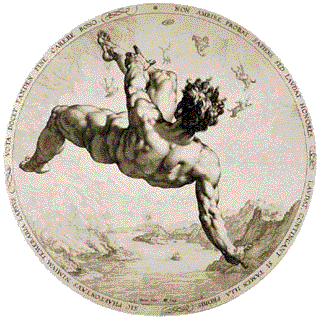1969 · Paris
by Raysse, Martial / Galerie Alexandre Iolas
Paris: The Artist / Expo 1969 - Galerie Alexandre Iolas, 1969. Fair. Original photograph (243 x 167), horizontal crease through center, some wrinkling, impressions of handwriting vision on emulsion (see below). APPARENTLY UNPUBLISHED IMAGE, DEPICTING THE INTERIOR OF THE GALLERY ALEXANDRE IOLAS IN 1969, ONE OF THE VERY FIRST PROJECTIONS OF RAYSSE'S ICONIC "FORME EN LIBERTE." THIS HIGHLY RECOGNIZABLE SHAPE BECOME INEXTRICABLY LINKED WITH THE WORK OF THIS EARLY POP ARTIST.
SIGNED ON THE VERSO IN PENCIL BY THE ARTIST, AND WITH HIS IDENTIFICATION OF THE PHOTOGRAPH IN FELT-TIP PEN.
Raysse obsessively explored the iconic "Forme en liberte" head and shoulders / keyhole design, repeating it in many different media including commercial design, for which he created the eau de toilette "Democratie Pour Homme" (1970) and thus anticipating Warhol's consumer products. This design represents a significant period in Raysse's career when he was experimenting with new materials and techniques, including this "magic lantern" projection.
In our photograph, not only can the projection of the "Forme en Liberte" be seen (on the ceiling) but the projector itself (on the lower left). There is an example of the projector at the Centre Pompidou and also at the Museum of Modern and Contemporary Art in Geneva. The present photograph was taken at the Galerie Alexandre Iolas Paris and is datable to September-October 1969. The work was first shown earlier in 1969 at the Galerie Der Spiegel de Cologne.
Pop artist Martial Raysse (b. 1936) is well represented in major museums worldwide, but his photographic work is not. He was a co-signatory of the Manifesto of New Realism in 1960. Famous for his colorful female figures from classic paintings, he also painted stereotyped faces of women borrowed from advertising from the early 1960s. Over time his representations of faces became more and more simplified until they became archetypes, as here. The "Forme en Liberte" verges on structuralism, seeking a root common to all men and women.
Concerning the present work, the artist stated that "I wanted to create through art a prototype that could be reproduced in thousands of copies, a kind of visual standard. That's why I took the shape out of its support, that's why I'm looking for other materials, less expensive than neon or plastic. A work is not something beautiful to look at - it is of no interest - its value is to be a school of thought. [...] I thus imagined a whole system of cut shapes, placed in front of a variable objective. The public will no longer need to have this form, it will simply grasp the idea." (Martial Raysse, cited by Lydie Brown, 1971). (Inventory #: 4299)
SIGNED ON THE VERSO IN PENCIL BY THE ARTIST, AND WITH HIS IDENTIFICATION OF THE PHOTOGRAPH IN FELT-TIP PEN.
Raysse obsessively explored the iconic "Forme en liberte" head and shoulders / keyhole design, repeating it in many different media including commercial design, for which he created the eau de toilette "Democratie Pour Homme" (1970) and thus anticipating Warhol's consumer products. This design represents a significant period in Raysse's career when he was experimenting with new materials and techniques, including this "magic lantern" projection.
In our photograph, not only can the projection of the "Forme en Liberte" be seen (on the ceiling) but the projector itself (on the lower left). There is an example of the projector at the Centre Pompidou and also at the Museum of Modern and Contemporary Art in Geneva. The present photograph was taken at the Galerie Alexandre Iolas Paris and is datable to September-October 1969. The work was first shown earlier in 1969 at the Galerie Der Spiegel de Cologne.
Pop artist Martial Raysse (b. 1936) is well represented in major museums worldwide, but his photographic work is not. He was a co-signatory of the Manifesto of New Realism in 1960. Famous for his colorful female figures from classic paintings, he also painted stereotyped faces of women borrowed from advertising from the early 1960s. Over time his representations of faces became more and more simplified until they became archetypes, as here. The "Forme en Liberte" verges on structuralism, seeking a root common to all men and women.
Concerning the present work, the artist stated that "I wanted to create through art a prototype that could be reproduced in thousands of copies, a kind of visual standard. That's why I took the shape out of its support, that's why I'm looking for other materials, less expensive than neon or plastic. A work is not something beautiful to look at - it is of no interest - its value is to be a school of thought. [...] I thus imagined a whole system of cut shapes, placed in front of a variable objective. The public will no longer need to have this form, it will simply grasp the idea." (Martial Raysse, cited by Lydie Brown, 1971). (Inventory #: 4299)




![[AMERICAN HERBARIUM 1883-1903]. Meticulously compiled and crafted Herbarium Notebook containing 58 botanical specimens from around the globe](https://d3525k1ryd2155.cloudfront.net/h/852/432/1681432852.0.m.jpg)
